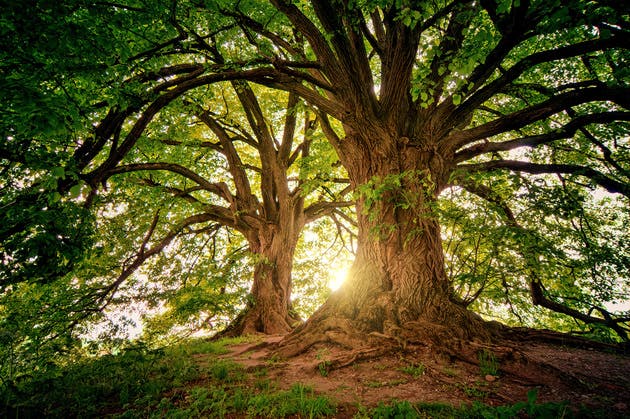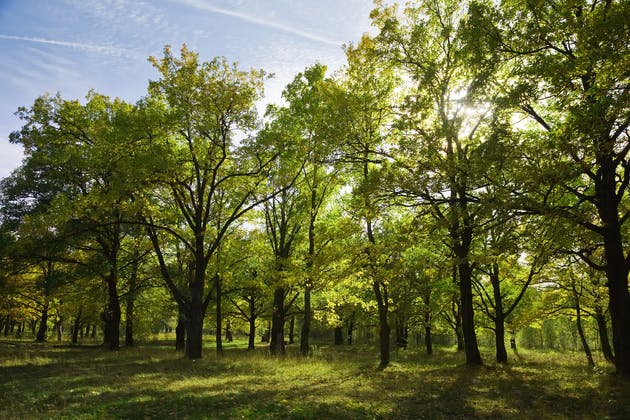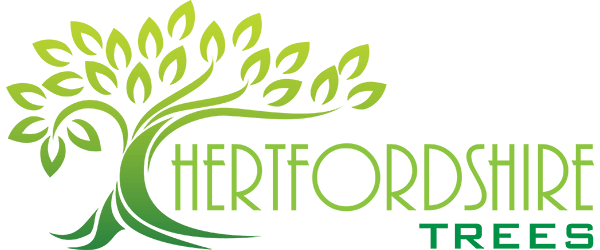At Hertfordshire Trees, we are aware of how crucial healthy trees are to preserving a thriving ecology. Unfortunately, illnesses can weaken or even kill trees if they are not treated, as they are also prone to them. To assist you in recognising some typical tree illnesses, we, as qualified tree surgeons, have put together this information.
Contact Hertfordshire Trees at 0777 574 3861 or email us at hertfordshiretrees@outlook.com for prompt and professional tree care services.

Common Types of Tree Diseases
Leaf Blotch
A fungus called leaf spot harms a wide range of tree species. Small, round dots on the leaves, which can be yellow, brown, or black, are its defining feature. In extreme circumstances, the leaves could fall too soon, weakening the tree. Fungicides can be used to treat leaf spots, but prevention is the key. Avoid watering the leaves, and make sure your trees are fertilised and kept properly.
Powdery Mould
Another fungus-related disease that affects numerous tree species is powdery mould. A white, powdery coating on the leaves, which can also cover the bark and branches, is what distinguishes it from other plants. The leaves could change shape or perhaps wither away. Fungicides can be used for powdery mildew treatment, but as always, prevention is vital. Make sure your trees are adequately cared for, fertilised, and watered without going overboard.
Dutch Elm Disease
Dutch Elm Disease is a fungal disease that damages elm trees. Bark beetles, which move the fungus from tree to tree, are responsible for spreading it. The leaves begin to curl, yellow, and wilt as symptoms, and then the branches and, ultimately, the entire tree die. Unfortunately, Dutch Elm Disease is incurable. To stop the illness from spreading, the affected tree must be removed and properly disposed of.
Oak Wilt
Oak Wilt is a fungal disease that damages oak trees. It can spread through root grafts made between trees that are close to one another as well as by sap-feeding beetles. Wilting, yellowing, and browning of the leaves are early signs, and then the branches and then the entire tree will die. Oak wilt cannot be cured, however, it can be controlled using proper tree care techniques, such as trimming and removing affected trees.
Emerald Ash Borer
The Emerald Ash Borer is an invasive beetle that has ravaged ash tree populations in North America. Now that it has been discovered in the UK, ash trees there face a major threat. The canopy may narrow, the bark may break, and D-shaped exit holes may appear in the bark as symptoms. Sadly, there is no treatment for the Emerald Ash Borer. To stop the beetle's spread, infected trees should be cut down and destroyed.

When to call a tree surgeon?
If you own property with trees, you might be unsure about the right time to contact a tree surgeon. Following are some situations where hiring a professional may be necessary:
Tree Pruning
Pruning is a crucial part of tree management since it keeps your trees healthy and at their best looking. It might be advisable to hire a tree surgeon to handle the pruning if you have enormous or hard-to-reach trees. A tree surgeon will have the tools and knowledge needed to prune your trees securely and efficiently.
Tree Removal
A tree may need to be entirely removed if it is dead, sick, or presents a safety risk. Especially for huge trees, tree removal can be perilous. A qualified tree surgeon can remove the tree safely while minimising the chance of property damage.
Tree Health
It's critical to take early action if your trees exhibit any symptoms of disease or deterioration. A tree surgeon can identify the issue and suggest the best course of action, such as trimming, fertilisation, or insecticide application.
Storm Damage
It's critical to evaluate the amount of any storm-related damage to your trees to decide whether or not the tree may be rescued. This examination can be assisted by a tree surgeon, who can also carry out any required maintenance or removal.
Construction
It can be required to cut down or remove trees to make way for the development if you intend to build on your property. A tree surgeon can provide the necessary services and assist you in identifying which trees require pruning or removal.
If you want to know more about our recent projects, please visit our gallery page and check out our customer's reviews regarding our services.
Tree Disease FAQs
The landscape would not be the same without its trees, which offer aesthetic value, shade, and environmental advantages. But just like any other living thing, trees may get sick. The following are some commonly asked questions concerning Hertfordshire's common tree diseases.
If you need expert advice from a tree surgeon in St Albans, Hertfordshire, Harpenden, or the surrounding areas, call us on 07775 743861.
What are the most common tree diseases in Hertfordshire?
Diseases including Horse Chestnut Bleeding Canker, Phytophthora Root Rot, Oak Processionary Moth, and Ash Dieback frequently harm trees in Hertfordshire. If these diseases are not addressed, trees may sustain serious harm.
How can I identify if my tree is diseased?
Keep an eye out for symptoms including early leaf loss, odd growths (such as cankers), wilting, dieback of branches, and peculiar leaf discolouration. Pest infestations such as aphids or caterpillars can also point to underlying problems with the health of the tree.
What should I do if I suspect my tree is diseased?
It's critical to take immediate action if you observe any illness or decline indicators in your tree. To determine the best course of action for treating the tree and to evaluate its condition, get in touch with a Hertfordshire arborist or tree surgeon.
Can tree diseases be prevented?
Although immunity to diseases cannot be guaranteed, there are ways to reduce the risk, especially with proper tree care techniques. A tree's natural defences against diseases can be strengthened by regular inspection, suitable pruning, preserving the quality of the soil, and avoiding stress factors like over- or underwatering.
How are tree diseases treated?
The type of illness and the type of tree that is afflicted determine the treatment options. These could involve strengthening soil drainage, using fungicides or insecticides, trimming afflicted branches, or putting in place cultural techniques to increase tree vigour.
Are there any regulations regarding diseased trees in Hertfordshire?
Indeed, laws are in place to stop the spread of diseases that affect trees, such as Ash Dieback. To preserve surrounding trees and woodlands, property owners are frequently obliged to maintain or remove diseased trees.
Ready to get in touch?
If you are unsure whether you need to call a Tree Surgeon, it is always best to err on the side of caution and consult with a professional. Contact Hertfordshire Trees at 0777 574 3861 or email us at hertfordshiretrees@outlook.com for prompt and professional tree care services.


